Top 10 Judge Dredd Stories
01/02/2017
From Oz to Necropolis
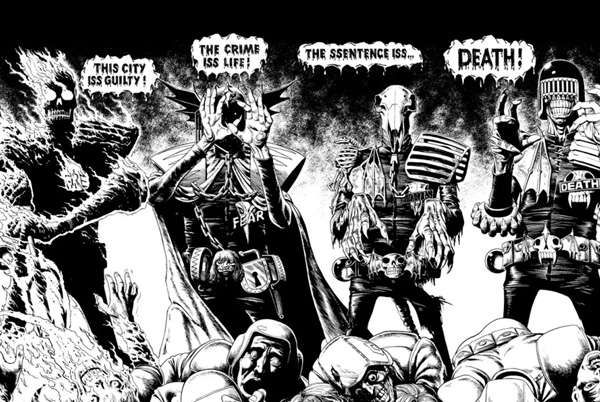
(1987-90, progs 545-570, 583-584, 650-699)
Writers: John Wagner, Alan Grant
Artists: Cliff Robinson, Jim Baikie, Garry Leach, Will Simpson, Brendan McCarthy, Steve Dillon, Barry Kitson, John Higgins, Jeff Anderson, John Ridgeway, Carlos Ezquerra
This is a slightly different example and sadly, unlike The Dark Judges, a collection doesn’t yet exist of this story arc as it takes place over a number of issues and over a number of years. Many will also debate at which point it’s necessary to actually start. However, going back to its earliest beginnings of the storyline – which isn’t essential to enjoy the main thrust of the plot that comes in the trio of stories The Dead Man, Tale of the Dead Man and Necropolis – takes the enjoyment level up just that extra notch.
The focus of this storyline is Dredd’s growing disillusionment with the Justice system and his place within in. This comes to a head when he is asked to carry out the final evaluation on a rookie judge Kraken, who is a Dredd clone. Events during the evaluation take their toll on Dredd and he resigns and takes the traditional “long walk into the Cursed Earth”. In his absence however, Judge Death returns and literally turns Mega-City One into a city of the dead. Dredd is forced to return and confront his nemesis and Judge Kraken, the man who replaced him.”
As writer Mike Hodder says, “Kraken, despite occupying the role of one of the main antagonists throughout this arc, is an immensely sympathetic character, and to understand that you need to know where he came from, and to understand that you need to go back to the very beginning of the arc to the Dredd mega-epic Oz. This is a great story in its own right, but it’s the seeds planted here that spring forth a little later in the two-part story Bloodline, compounded by the one issue story The Shooting Match that gives the impression that something is building, that something is going to happen.”
Reading this arc is a big undertaking, but one that is immensely rewarding as the themes and strands woven through the years all collide in a spectacular epic. You’ll find a few of these stories on every Dredd top 10 list, but this is how they fit together. They’re all available in various editions of the Judge Dredd Case Files collections and some in dedicated graphic novels.
Oz (prog 545 – 570)
Bloodline (prog 583 – 584)
The Shooting Match (prog 650)
A Letter to Judge Dredd (Prog 661)
The Dead Man (prog 650 – 662)
Tale of the Dead Man (prog 662 – 668)
By Lethal Injection (prog 669-670)
Rights of Succession (prog 671)
Dear Annie (prog 671-672)
Necropolis (prog 673-699)
Block Mania/The Apocalypse War
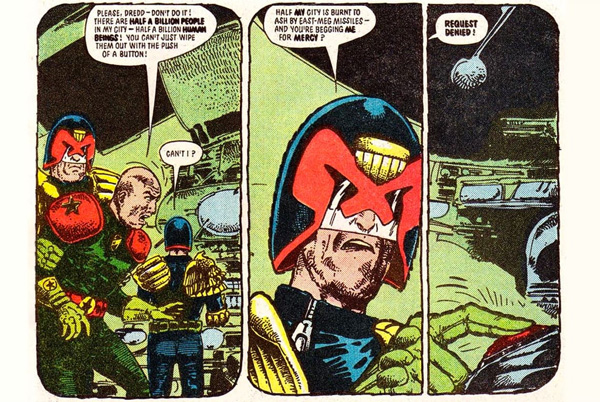
(1981-82, progs 236-267, 269-270)
Writers: John Wagner, Alan Grant
Artists: Mike McMahon, Ron Smith, Steve Dillon, Brian Bolland, Carlos Ezquerra
It’s not uncommon for tempers to snap and Block Wars to break out between the massive apartment buildings in the dystopian sprawl of Mega-City One. However, when the whole city descends into block-on-block mayhem, Judge Dredd suspects a conspiracy. It turns out the whole thing was orchestrated by the Soviet citystate, East Meg One – and with the judges weakened, the Sov Judges launch an all-out attack.
The first part of this story, Block Mania was illustrated by the incredible Brian Bolland and features an epic fight in the rain with East-Meg agent Orlok.
Later, in the second half of the story, The Apocalypse War, Dredd and his squad infiltrate a Sov missile silo. Here he is begged by a Sov Judge to spare East Meg One from its own missiles. “There are half a billion people in that city,” he cries. “You cannot wipe them out with a push of a button!” Dredd’s response? “Can’t I? Half my city has been burnt to ash by East-Meg missiles and you’re asking me for mercy? Request denied.” And with that, he basically commits genocide, killing 500,000,000,000 innocents because it’s the only way to save his city. It’s a pivotal moment in Judge Dredd’s history, it shows beyond any shadow of doubt that he is someone who will stop at nothing to do whatever must be done, regardless of the consequences.
The Pit
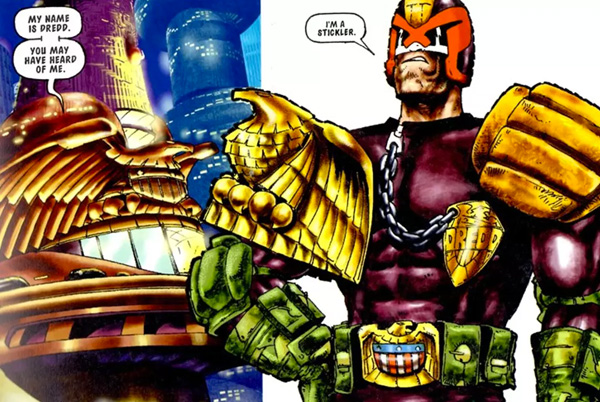
(1995-96, progs 970-999, graphic novel)
Writer: John Wagner
Artists: Carlos Ezquerra, Colin MacNeil, Lee Sullivan, Alex Roland
The Pit ushered in the ‘modern age’ of Judge Dredd, one focusing on the day-to-day of a struggling Justice Department sector house in Mega-City One’s most crime-ridden zone. 2000AD started to follow more of the flawed supporting characters as they weaved their way through right and wrong, with Dredd on hand to offer guidance. This had been touched on briefly in the 1983 story The Graveyard Shift, but it’s The Pit that explored it to any significant depth.
‘The Pit’ is the colloquial name for sector 301 of Mega-City One, which has become a dumping ground for every useless and corrupt Judge in the city. Dredd is brought in to take up a role he’s not done before, Sector House Chief after the untimely death of the previous incumbent, and its his job to turn performance of the sector around and purge it of its corrupt elements.
What makes this a good story is the supporting cast around Dredd, and indeed, many step into the spotlight. Each has their own distinct personalities, each has their own purpose in the story and each has their own secrets that Dredd manages to uncover. Nothing gets nuked and there isn’t a bodycount that runs into the hundreds or thousands, but what it gives us is a permanent change to the way in which Dredd’s world is shown to us, by the introduction of a number of secondary-yet-significant characters over the next few years.
The Judge Child
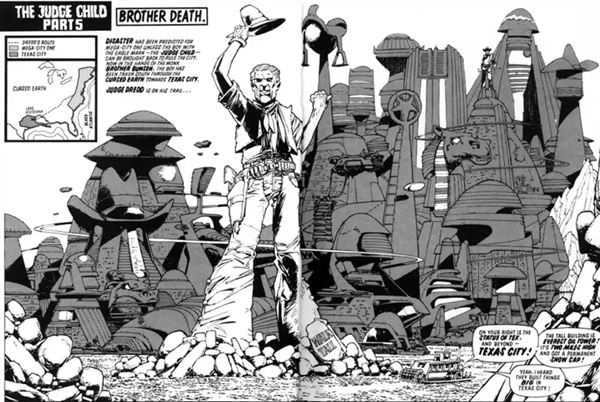
(1980, progs 156-181, graphic novel)
Writers: John Wagner, Alan Grant
Artists: Mike McMahon, Brian Bolland, Ron Smith
A dying member of Psi Division has a precognitive vision that Mega-City One will be destroyed unless the Judges can find the “Judge Child,” a boy called Owen Krysler with extreme telepathic and precognitive powers. Dredd is sent after the boy and tracks him across the Cursed Earth to Texas City where the Judge Child falls into the hands of the Angel Gang who escape from Earth. Dredd pursue the gang and the Child across a number of star systems and through various strange encounters with alien worlds.
The first long-form John Wagner and Alan Grant team-up gives us Judge Hershey in her debut appearance, the first encounter with the fearsome Mean Machine Angel, a first look at the cowboy chic of Texas City, Dune-inspired Oracle Spice hallucinations and an alien wasting disease known as “Jigsaw Disease,” which causes the victims to vanish piece by random piece.
Brothers of the Blood
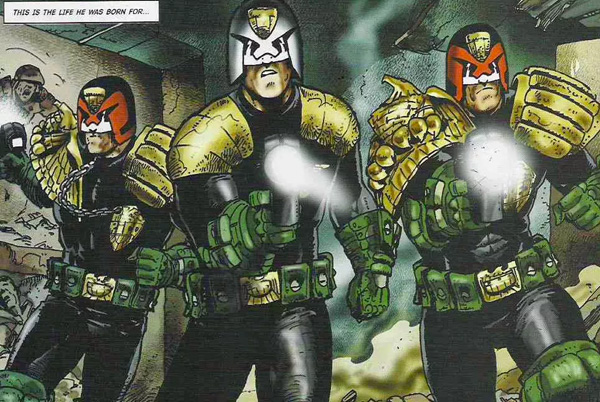
(2000-04, progs 186-1188, 1215-1222, 1280, 1281, 1300, 1301, 1350-1356 and 1378-1381, graphic novel)
Writer: John Wagner
Artists: Simon Fraser, Carlos Ezquerra, Ian Gibson, Colin MacNeil
Not really one story arc, but a collection of loosely grouped stories set around the closest thing Dredd has to a biological family.
Dredd is a clone of one of the founding judges, Judge Fargo. However, he is not the only clone. Way back in prog 30 we were introduced to Dredd’s evil twin, Rico and this is a collection of loosely grouped stories set around the closest thing Dredd has to a biological family – his disgraced clone brother, Rico’s illicit daughter Vienna and a younger clone who has chosen to also take the name Rico – and the bond they share, these polar opposites and this anomaly in an actual relative that they both care for.
Brothers of the Blood also introduces another Dredd clone, Dolman, who is a cadet at the Academy of Law. He performs well at the Academy, but resents his lack of control over his own life and chooses to leave the Academy and Mega-City One. As a Dredd clone, Dolman is too valuable an asset to let go without at least giving him the opportunity to experience life as a judge on the streets of Mega-City One. So Dredd and younger Rico team up with Dolman and three generations of clone brothers dispense justice, albeit for short while. Instead however, he joins the Space Corps and is transferred to an offworld Academy, though he regularly returns to the city and keeps in contact with Vienna Dredd.
The characterizations of three generations of Dredd, different ages but exact duplicates, gives a unique perspective on what being a judge means in Mega-City One. They are quite literally born to this job, yet they each look at it in from a different perspective.
Pages: 1 2